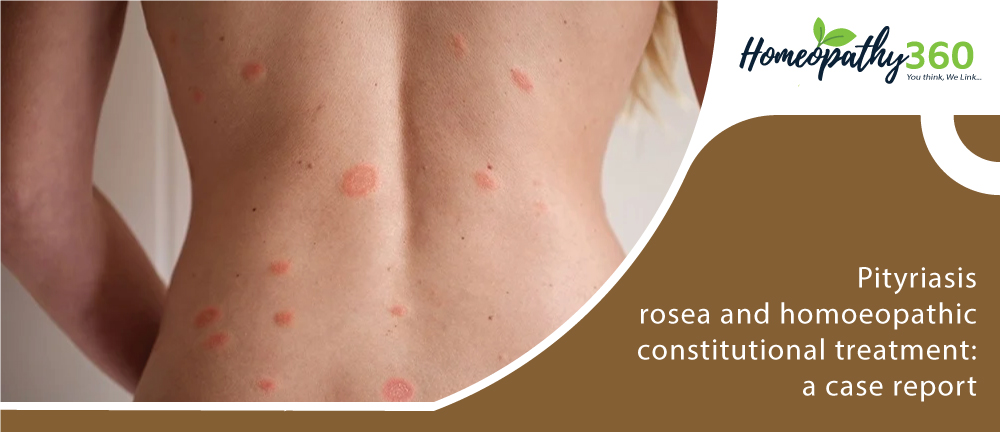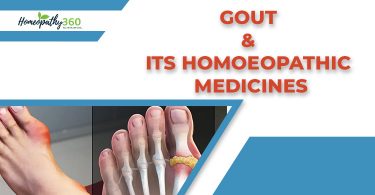
Pityriasis Rosea Rash: Symptoms, Causes, & Treatment with Homeopathic Medicine
Abstract
Healthy skin has a powerful impact on our emotional and mental well-being, it will give you confidence and a better appearance. But whenever you develop a skin related disease condition, it will not only affect your skin but also lower self-confidence. A case report of pityriasis rosea in 29 years old female patient who was treated successfully with constitutional homoeopathic medicine. Lycopodium clavatum was prescribed as a constitutional remedy on the basis of totality of symptoms. Homoeopathy and its holistic approach of finding a constitutional remedy provide a way for the treatment of such type of cases successfully.
Keywords: pityriasis rosea, homoeopathy, constitutional medicine, Lycopodium clavatum
Introduction
The term ‘pityriasis rosea’ denotes‘fine pink scale’, which was first described by Gilbert in 1860 (1). It manifests as an acute, self-limiting eruption with the duration of 6-8 weeks which evolves rapidly, usually beginning with a patch that heralds the eruption and called ‘herald patch’ (1). It commonly affects young adults with a slight female predominance and usually occurs in summer and spring with an unknown aetiology. It is characterised by the appearance of a ‘herald patch’, an oval lesion with central pinkish centre, a darker periphery and a characteristic collarette of scale (2). The most common location on the body is chest, back, neck, upper arms and upper thighs (3).
CASE:
A 29 years old female patient came with the complaints of reddish scaly eruptions on extensor surface of left arm which persisted for last four weeks. There was no itching but margin of eruptions was quite clear, red and scaly in appearance. Rashes were present on the upper thigh also.
History of the patient
Eruption was dry, reddish, scaly without itching for the past one month.
Past history
Nothing significant
Family history
Father died due to cancer of liver. Mother had hypertensive and taking conventional medicine.
Personal history
Head trauma 9 years ago. History of irregular menstruation. She had no any addiction.
Life space investigation
She was from upper middle class. Since childhood, she was patient and calm but now felt irritated, hatred to men, society and thought of people. Her education and professional life were good. She was unmarried.
Mental symptoms
When enquiring about her mental symptoms, she felt abandoned or not loved by her family members, friends or relatives. She felt sadness which in turn causes anger. She strangely felt hatred especially to men. She does not want to get married even the idea or thought of marriage is unbearable for her. She was constantly dwelling on past bad incidents and those misfortune humiliated her. She felt betrayed. She disliked music.
Physical generals
She had good appetite and thirst was moderate. She had desire for spicy food. Her hairs were falling out started from vertex then from temples region of head. Stool was hard at first then soft. Rectum was excoriated due to constipation. There was burning on the foot sometimes.
Diagnosis
Diagnosis was made on the basis of sign, symptoms and physical examination of the patient (3).
Analysis and evaluation of symptoms
| Sl. No. | Classification of symptoms | Symptoms | Intensity |
| 1. | Mental generals | Felt abandoned | +++ |
| Thinking about past bad incidents humiliated her | ++ | ||
| Felt betrayed | +++ | ||
| Dwelling and recalling on past memories | +++ | ||
| Felt hatred to men | ++ | ||
| Cannot tolerate the idea of marriage | +++ | ||
| 2. | Physical generals | Drinks moderate quantity of water | ++ |
| Desire for spicy foods | + | ||
| 3. | Particular symptoms | Hair falling from temples | +++ |
| Rectum excoriated | ++ | ||
| Red, scaly and dry eruption on left arm and upper thigh | +++ | ||
| Burning on foot | + |
Totality of symptoms
After analysis and evaluation, the symptoms were used in constructing the totality of symptoms were;
- She felt abandoned or not loved by her family and friends.
- Thinking about her past bad incidents those misfortune humiliated her.
- She felt betrayed or deceived which causes grief and mortification.
- Dwelling on past disagreeable occurrences and always recalling those memories.
- Felt hatred to men, society and thought of people.
- She cannot tolerate the idea of marriage.
- She felt sadness which in turn causes anger.
- Her hair was falling out started from vertex then from temples region of head.
- Stool was hard at first then soft.
- Rectum was excoriated due to constipation.
- Eruption is dry, reddish, scaly without itching on extensor surface of arm.
Conversion of symptoms into rubrics
| Sl. No. | Symptoms | Rubrics with chapter |
| 1. | Her hair was falling out started from vertex then from temples region of head. | Head – Hair falling – temples |
| 2. | She felt abandoned or not loved by her family and friends. | Mind – Abandoned feeling – feels of not being loved by parents, family. |
| 3. | She felt betrayed or deceived which causes grief and mortification. | Mind – Deception – causes grief and mortification. |
| 4. | Dwelling on past disagreeable occurrences and those memories. | Mind – Dwells on past disagreeable occurrences – recalls disagreeable memories. |
| 5. | Felt hatred to men. | Mind – Hatred men to |
| 6. | Thinking about her past bad incidents those misfortune humiliated her. | Mind – Humiliation – ailments from |
| 7. | She cannot tolerate the idea of marriage. | Mind – Marriage |
| 8. | She does like to listen music. | Mind – Music aggravation. |
| 9. | Rectum was excoriated due to constipation. | Rectum – Excoriation. |
| 10. | Eruption is dry, reddish, scaly without itching. | Skin – Eruptions – scaly – white. |
| 11. | Stool was hard at first then soft. | Stool – Hard first then fluid |
Repertorisation(4):
Repertorial sheet:

Repertorial analysis;
Lycopodium calvatum – 11/23
Natrium muriaticum – 6/13
Calcarea ostrearum – 7/11
Ignatia amara – 5/11
Sepia officinalis – 6/9
Repertorial selection;
On the basis of repertorisation and totality of symptoms, Lycopodium clavatum got hightest marks to the totality of symptoms. The strong mental symptoms clearly indicate the remedy. The other remedies came out on repertorisation were Natrium muriaticum, Calcarea ostrearum, Ignatia amara, and Sepia officinalis. After consulting the materia medica as a final court of appeal medicine, Lycopodium clavatum was chosen.
Prescription
Lycopodium clavatum 200/1 dose was given on the first visit 18/05/2021 in empty stomach early morning for regular three days.
Follow up:
| Date | Response | Prescription |
| 26/05/2021 | Felt 25% better, lesion remained | Rubrum 30 was given for next 15 days. |
| 12/06/2021 | Scaling of eruption was less, redness diminished. | Rubrum 200 was given for next 15 days. |
| 23/06/2021 | Eruption persists, new eruption appeared on right arm. | Lycopodium clavatum 1M/1 dose was given. |
| 07/07/2021 | Lesions started shrinking. Stool got normal. | Rubrum 200 was given for the next 15 days. |
| 19/07/2021 | Right arm lesion vanished, left still shrinking in size. | Rubrum 200 was given for the next 15 days. |
| 08/08/2021 | Improvement went on. No new symptom appeared. | Rubrum 200 was given for the next 15 days. |
| 20/08/2021 | Lesions completely disappeared. She looked happy. | No medicine was given. |
Justification for selection of remedy and potency
According to aphorism 272 of Organon of Medicine, single remedy was prescribed at a time and aphorism 275 stated that suitableness of remedy not only depends on accurate selection of remedy but on the smallness of doses too (5), because of that reason I prescribed only one dose. For the selection of potency, susceptibility is the only guiding factor. The axiom used for this purpose is “more the susceptibility – higher the potency, less the susceptibility – lower the potency” (6). As the susceptibility of the patient was high, potency was chosen higher.
Discussion
As per aphorism 225, 5th edition, Hahnemann stated that some emotional diseases originated by emotional causes such as continued anxiety, worry, vexation, wrongs, and frequent occurrences of great fear and fright. These emotional diseases destroy the corporeal health often to a great degree. Aphorism 201 stated that when man’s vital force encumbered with chronic diseases like that and unable to overcome by its powers, so it adopts the plan to transfer the internal disease to the external part or those part of body which is not indispensable to human life (5). In this case she was remaining in a constant state of anxiety, worry and wrongs for a long time seems a chronic disease and there appears the skin lesions. Aphorism 193 stated that when medicine is employed internally in the diseases of recent origin, it removes the general morbid state along with the local affection (skin lesions) and the latter is cured at the same time as the former which proves that the local affection solely depended on the disease of the whole body (5). After administering Lycopodium clavatum, skin lesions are removed along with the general morbid state including mental symptoms. Dr Kent introduced a doctrine in the treatment of chronic diseases known as ‘series in degrees’ (7) which was implied in this case.
Conclusion
Homoeopathy by its constitutionally selected medicinal treatment not only cure external lesions but to treat the patient on emotional plane too. Homoeopathy is a system where individualistic approach of selecting constitutional remedy cure any kind of disease successfully. Here, Lycopodium clavatum played a vital role on skin lesions as well as the underlying cause or the disturbed vitality that produces it. The annihilation of external lesions is the evidence that she was cured completely.
References
1.Schwartz R A. Pityriasis Rosea [Internate]. [Updated 2021 Feb 11; Cited 2021 Sept 27]. Available from: http://emedicine.medscape.com/article/1107532-overview
2. Davidson’s. Principals and Practice of Medicine. 22nd edition. New York: Churchill Livingstone; 2014.
3. Pityriasis rosea [Internate]. [Cited 2021 Sept 27]. Available from: https://www.nhs.uk/conditions/pityriasis-rosea/
4. Kent JT. Repertory of Homoeopathic Materia-Medica, 3rd edition. Kolkata: Rup publication; 2016
5. Hahnemann S. Organon of Medicine. 5th & 6th edition. New Delhi: B. Jain Publishers (P) Ltd; 2014.
6. Mandal and Mandal. A TEXTBOOK OF HOMOEOPATHIC PHARMACY. Kolkata: New Central Book Agency (P) Ltd; Reprinted 2013, 2014. P – 398.
7. Tiwari Prof. Dr. Shashi Kant. ESSENTIALS OF REPERTORIZATION. 5th edition. New Delhi: B. JAIN PUBLISHERS (P) LTD; 2014. P- 255.
About the author
Dr Arti, BHMS, M.D.(HOM.) in the Department in Materia Medica, Assistant Professor at Muzaffarpur Homoeopathic Medical College and Hospital, Bihar.





